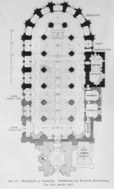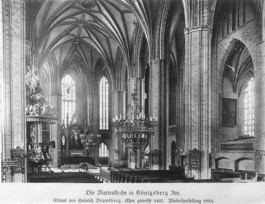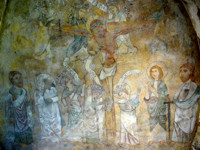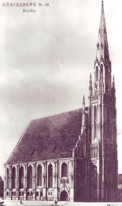Association for the reconstruction
of the St. Mary's Church in Chojna/Poland, formerly Königsberg/Neumark
 History of St. Mary's Church until 1945
History of St. Mary's Church until 1945
Previous Churches
Today's St. Mary's Church, sitting on a little higher ground in the town, is not the first church at this site. During excavations an older church made of simple stones was discovered, with a ground plan above a greek cross. It was mentioned as a patronate church of the Knights Templar already in 1282, being 35m long and 25m wide and having a nave being 9m wide. In the west it reached to the tower. Rests of the walls of granite stone can still be seen in the upper as well as the lower St. Mary's chapel and on the outer wall.
Brunsbergh-Church from 1389
Builder
Heinrich Brunsbergh
Building the new church started in 1389, probably under the patronate of the Knights Hospitaller. The choir of the old rectangular church was demolished up to the transept and the new church was built from the east by the builder Heinrich Brunsbergh from Stettin. He had planned a hall church with a nave and two side aisles, all three being of the same height. Furthermore, it was completed by a choir gallery and ring of chapels above each other, consisting of seven pieces each. At first, he had planned only the three Langhausjoche but without a Querhaus. On the south side, he integrated an appendix with the lower and upper St. Mary's Chapels. This building was consecrated in 1407. After the consecration, the remnants of the old church were removed.
>> more on Heinrich Brunsbergh in an article by Peter Helbich (in German)

The second phase of construction is built in the same style and connected directly to the first phase, althoug it was not built before 1451-9. It seems to have been the same Bauhütte as Brunsberghs - while Brunsbergh himself probably had died 1435. The ornamentation and the decorating bricks are almost identical, the builders kept close to the original plans. The church was extended with three more bays till the western wall of the old church; a rectangular tower was also built in this period.
The nave and the upper St. Mary's Chapel were roofed with magnificent stellar vaults - with a noticeable characteristic: the east Prussian ridge rip (or lierne(?)). - (May Heinrich Brunsbergh have come from Braunsberg in East Prussia?) The choir gallery is equipped with Springgewölbe, the side aisles and the attached side chapels (quadripartite) with rib vaults.
Interior buttressesThe special characteristic of this church are, however, the buttresses that were moved inside the church as pilasters. These pilasters were penetrated for the upper galleries. Brunsbergh was the first to apply this technique in North Germany, maybe he even was its inventor. Thus, the outer wall was moved to the outside. In how far influences from Prague or Italian elements played a significant role, has still to be evaluated.
The exterior of the church ist structured by a two-storey window division with simple Maßwerkstäben and sehr flächigen Wandvorlagen at the height of the pilasters.The latter are characterised by a magnificent three-storey Wimperggliederung that runs around the church with red, brown and green bricks. The roof cornice is made of a frieze of circular elements. It is possible that today's straight roof edge was originally combined with a merlon fascia.
Because the church was, despite the disruption in the building with its visible seam in the eastern aisle, completed according to the original plans, it is one of the purest gothic buildings in eastern Europe.
Dimensions of the church:
Length excl. tower: 57,20 m, incl. tower 70,80 m
Width: 29,2o m, with the appendix of the St. Mary's Chapels 34 m, width of the nave 9 m
Height of the cornice of the nave and side aisles ca. 20m, up to the top of the roof 40m
Inner dimensions of the church hall: 54,40 long and 27,2 m wide
Height of the nave with vaults: 17 m.
 Restoration in the 19th century
Restoration in the 19th century

In the 19th century, between 1882 and 1884, the church was restored by Friedrich Adler and Peveling. Many of the fittings were removed. The magnificent baroque pulpit was preserved, a work of the Italian George Mattanovi, who built it between 1701 and 1714, donated by the merchant M. Biesel. Above that, the marvellous baroque organ from 1736, built by the famous Joachim Wagner from Berlin, was played until the end of the Second World War. The splendid baroque window paintings from the early 15th century were changed and only two of them preserved.
The neogothic altar, donated by the Prussian Queen Elisabeth at the occasion of the inauguration of the tower in 1861 and with an altar painting by Pfannschmidt, survived the thorough restoration. The gothic font, that originally stood in the destroyed St. Anne's Chapel, was moved into the southeast chapel, although not in its original appearance. Today, after the destruction, it is the only authentic piece of the interior fittings.

Also worth mentioning are to preserved gothic frescos from the 15th century: Fresco of the crucification of Christ by the Virtues - an ancient legend - and a madonna on a crescent moon.
 Important chapels
Important chapels
St. Mary's Chapel
The St. Mary's Chapel on the south side of the church is a double chapel qith a lower and an upper church, that were substantially built with the main church from 1389 and 1407. In its lower walls, remnants of the old stone church, the predecessor church, can be found.
The lower chapel, below the level of the nave and the side aisles, consists of two fields of bays with almost identical rib vaults and mask consoles as they are also built in the chapel ring of the main church - evidence for the significance of this part of the church. This chapel was the only room that could be locked with a solid door and that could be heated. From the 16th century, it served as the sacristry and as the storage place of the equipment for the holy communion as well as the old documents, the "box of the parish", the money chest for the collection, and for the indulgence and other payments. It may also be used as a congregation room, maybe even for council meetings of the municipality. From the end of the 19th century, this formerly representative room contained the central heating boiler.
The upper chapel was and still is open towards nave and aisles and was presumably used for special services to St. Mary.
>> more on the St. Mary's Chapel in an article by Peter Helbich )(in German)
St. Anne's Chapel
The former St. Anne's Chapel was located south of the tower. It was built appended to the church until 1479 and in alignment with the southern wall. It had two bays, that were built with stellar vaults and two two-storey windows. In 1843, it was destroyed by the collapsing tower and consequently demolished.
 The Tower
The Tower

The tower that today is 102 m high, was built between 1854 and 1861 by the architect Friedrich August Stüler from Berlin. It replaced the previous tower that had collapsed in 1843. The tower is made of bright red bricks, and is in its lower, square part divided into three storeys: portal storey with a rosette above the entrance, gallery of the apostles, following French galleries of kings, and, finally, the bell storey with huge Maßwerkfenstern. The octogonal helmet, based on an octogonal substructure, was originally entirely built of bricks. It had eight huge windows with Wimpergen, that made the tower to appear very transparent. It was approximately 95m high.
Due to heavy damages, the tower had to be taken down again already in 1881/82 and was rebuilt in the original type. In 1932, even this filigree spitze was damaged so that it had to be secured with steel bands. Four of the Wimpergfenster were bricked up and all Wimperge removed. The entire helmet was then covered in a rather simple way with copper. Additionally, the new helmet got four Fialtürme. To strengthen the octogonal substructure, a square-shaped clock-storey was erected that is still visible today. In this appearance, the tower stood until the desctruction of the church on February the 16th 1945. That is the way it is rememembered by most of the old inhabitants of Königsberg.
 Desctruction
Desctruction
As the old town and the town hall, the church burned after the arrival of the Red Army. The wooden parts as the roof truss, the cover of the tower and the rich, baroque and neogothic fittings were entirely destroyed. The magnificent stellar vaults collpased and fell onto the main pillars which were damaged considerably. The bells destroyed the vaults in the tower.